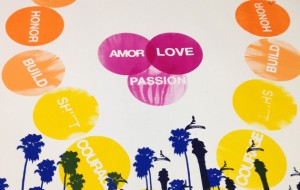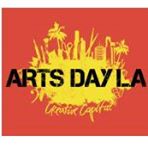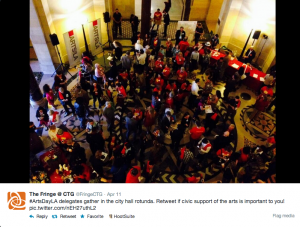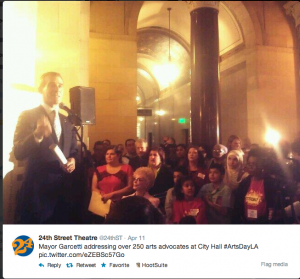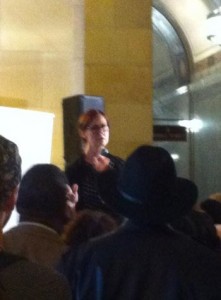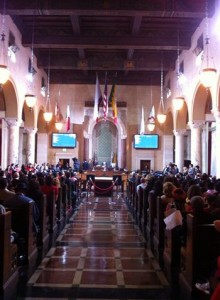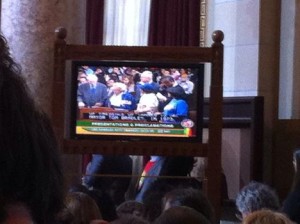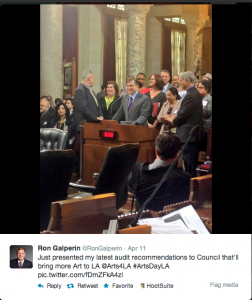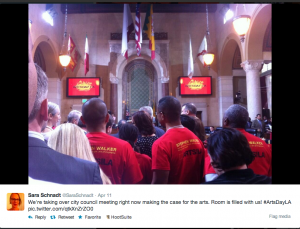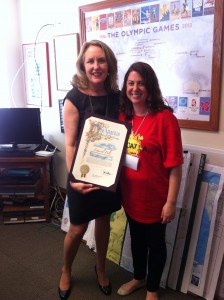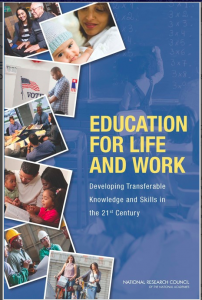reposted from http://namle.net/2014/04/25/org-member-profile-tribeca-film-institute/
by Laurel J. Felt | April 25, 2014
Tribeca Film Institute, an affiliate of the well-known Tribeca Film Festival, offers cutting-edge, socially conscious educational opportunities for youth across New York City. Tribeca Education and Engagement Coordinator Flonia Telegrafi recently took the time to discuss with me Tribeca’s educational impacts, offerings, and plans for the future.
IMPACTS
Founded in the wake of September 11, 2001, Tribeca aims to support community-building by sharing socially relevant stories, empowering storytellers, and working with youth. Its extensive and process-based education department, staffed by individuals who either have taught or still are teaching, outreaches year-round to educators and students. Collectively, Tribeca’s five education programs aspire to “help young people gain the media skills necessary to be productive global citizens and creative individuals.”.
Explained Telegrafi, “The largest program we have is called Tribeca Teaches. We’re in 30 K-12 schools all throughout the five boroughs, and we send a teaching artist into these schools for a year-long residency. They work with students both in-class or after-school (depending on the specific residency) to make films.” In so doing, Tribeca Teaches seeks to “help children with expression tools, self-discovery, bring young people together whether they’re classmates or peers in a school, and really explore storytelling as a tool for self-expression.”
Last year, one of Tribeca Teaches’ participating schools was the East River Academy, an educational program serving incarcerated students aged 16-21 on Rikers Island. Thanks to a grant provided by New York’s Hive Learning Network, Tribeca is currently wrapping up its second year on Rikers Island at the Rose M. Singer Center, the only all-female facility on the island.
Telegrafi herself teaches Rikers’s 40 participants per year, and uniquely designed the curriculum to accommodate the contextual constraints of a jail. For example, because the students enter and leave Telegrafi’s tutelage as they enter and leave the facility, “it’s really important to scaffold the lesson. If a student is in the classroom for only two sessions, they can complete something,” said Telegrafi.
This “something” might be finishing a writing prompt, creating a spoken word poem, or recording their voice. Because surveillance equipment — which includes video cameras — is not permitted on Rikers, students cannot capture their own footage. But this doesn’t prevent their filmmaking.
“We instituted an exchange with one of our Tribeca Teaches classroom on the outside, the Young Women’s Leadership School in Astoria,” explained Telegrafi. First, she asked her Rikers students to consider “what their version of the world would look like if they had all the power.” Next, they wrote poems visualizing this world and recorded their own recitations via Garage Band. Then Astoria students received these recordings along with a shot list and filmed images around the neighborhood and city that, they believed, respected their partners’ vision. Finally, Rikers students took the footage and edited together their own videos.
“What we discovered is that art is an amazing tool to increase self-esteem,” enthused Telegrafi. “Doing and reinforcing self-esteem through art-making, where there’s lots of do-over and that’s okay, I feel like it drives home the fact that there is no right and wrong, you can do it over and that’s okay… It’s not about black-and white or right and wrong, you can keep growing and learning just by doing and redoing. Art and filmmaking reinforces that… And the fact that the young women are using MacBooks and don’t have to share, they’re working on their own computer, and using FinalCut, a professional editing tool, and getting over the frustration to get good at it, and not pushing the computer away…” Telegrafi trailed off. Obviously, the impacts of this engagement are significant. Telegrafi also points to “the validating aspect of being able to share their work and their words with the young women outside, having an actual audience.”
Sharing with audiences occurs both on and off the island. At Rikers, “as soon as they [the students] finish something, even if it’s a rough cut, we invite people in to take a look. It shows that the women are willing to share, open to feedback, and are just proud of their work.”
Back on the mainland, Tribeca Teaches culminates with an annual screening of the students’ work, which is integrated within the Tribeca Film Festival. Held just a few days ago (April 25) at the 1000-seat Tribeca Performing Arts Center, this celebratory event enabled students, families, teachers and members of the public to appreciate participating youths’ creativity and perspectives. “We actually rent buses for each school so they come in busloads,” said Telegrafi. “We also reserve seats for students who didn’t partake in the program.” Read more about the partnership at Rikers, and the experience of one liberated inmate as she witnessed her film’s debut in The New York Times.
OFFERINGS
The Tribeca Youth Screening Series pursues media literacy through more “traditional” channels, via screening socially relevant films and discussing these films’ implications. Notably, educators from around the world can access Tribeca’s original curricula and Educators’ Guides.
Rather than a foray into art-making, like Tribeca Teaches, this program is “seen more as an intellectual exercise, building students’ capacity to examine, deconstruct, analytically discuss.” What do they discuss? “Issues, stereotypes, different social justice aspects,” listed Telegrafi. “In a year’s worth of schooling, where students are exposed to math, science, social studies, we think it’s important that they also understand that they have a voice and can make educated decisions.”
Ten diverse schools situated across New York City participate in the Tribeca Youth Screening Series. Each fall and spring, these students explore four films that look at a particular theme. Said Telegrafi, “We want to always make sure that the themes we select and the films we screen resonate with students’ identities and backgrounds. We’re always thinking in terms of points of access.” An understanding of participating students’ origins, e.g., where some students have immigrated and where they currently reside, informs the curation process. This past fall of 2013, Tribeca Youth Screening Series investigated “food justice”; this spring, the theme was “home,” explored via the films Persepolis,Do the Right Thing, Herman’s House, and Inocente.
Youths from every school attend the four film screenings together, which provides a special engagement opportunity for members of various communities who meet rarely, if ever. For example, schools in the Bronx and Brooklyn participate in this series, as well as three English Language Learner institutions respectively located in Queens, Chinatown and Union Square. As soon as the lights go up after each film, associated directors, producers, or actors welcome questions from the student audience. According to Telegrafi, this provides “…a forum where they can ask questions and are not afraid to make a point. So it’s important in terms of opening people’s minds to different perspectives and realities, and taking that back to their homes, communities, and classrooms.”
Before and after each screening, Tribeca equips teaching artists with original curricula and sends them to every participating school in order to facilitate additional in-class discussions — 8 sessions in all. In terms of the curricula, Telegrafi explained, “We’re looking to address the issues that are raised in the films through different hands-on, student-driven activities… [Educators’ Guides] include activities around keywords and actual discussion prompts, and have a thru-line and make sense from pre to post.”
This program also ends with a final celebration. Because Inocente examined art — specifically, art’s role in empowering a 15-year-old, homeless, undocumented immigrant, Tribeca invited professional muralists to wrap up the spring series by assisting students in their own mural-making. Like the film’s protagonist, Tribeca’s “graduates” appropriated color and form to tell stories, make statements, and re-dedicate themselves to their dreams.
“The overall goal is to ensure that young people are open and receptive to seeing different life experiences acted out on film,” Telegrafi elucidated. “One of our main goals is to introduce the young people who participate to different cultures so that we leave our daily life for a second and observe and try to understand how somebody else is living.
“We hope that, not only are they engaging in conversations in the classroom and are able to analyze a film by breaking down the different issues and themes that affect our lives, but that they’re open to debate, friendly debate, conversation. Hopefully watching one of these films will change their mind or their perspective on an issue. Maybe they’ll leave more open-minded and see somebody else’s point of view.”
Also of note to local media educators is Tribeca’s Blueprint For The Moving Image. This program consists of three, large-scale professional development sessions offered each spring, various skill-building workshops on Saturday’s, and the option to receive teaching artists who will offer classroom-based instruction in whichever areas the teachers have expressed interest over a three-day residency period.
Articulated Telegrafi, “Our purpose is to not only to provide these workshops where they’re exposed to new tools, technologies, ways of designing a lesson or approaching a topic through media, but [to offer] a place where media teachers across the city can get together and meet each other and be part of a learning professional network of their peers.”
PLANS FOR THE FUTURE
“We’re going to continue doing the work that we do,” said Telegrafi. That work entails “…constantly assessing, checking in with folks. We’re trying to listen to folks and their needs and have that inform our process. But definitely [we plan on] exposing more young people to filmmaking, art-making, [and we will be] building platforms for our students’ work, getting our Rikers students’ work out, and inspiring young people across the city to the possibilities of art and having their voice heard and expressing themselves.”
Tribeca Film Institute’s Director of Education Vee Bravo also shared his big picture visions. “In the future we imagine an educational environment where media literacy programs reach multi-generational students through partnerships among schools and institutions such as prisons, hospitals, environmental and social justice groups. This means redefining the classroom into a lab where the make-up of students includes young people, teachers, parents and professional artists collaborating on meaningful art projects.”
NAMLE salutes the Tribeca Film Institute!


